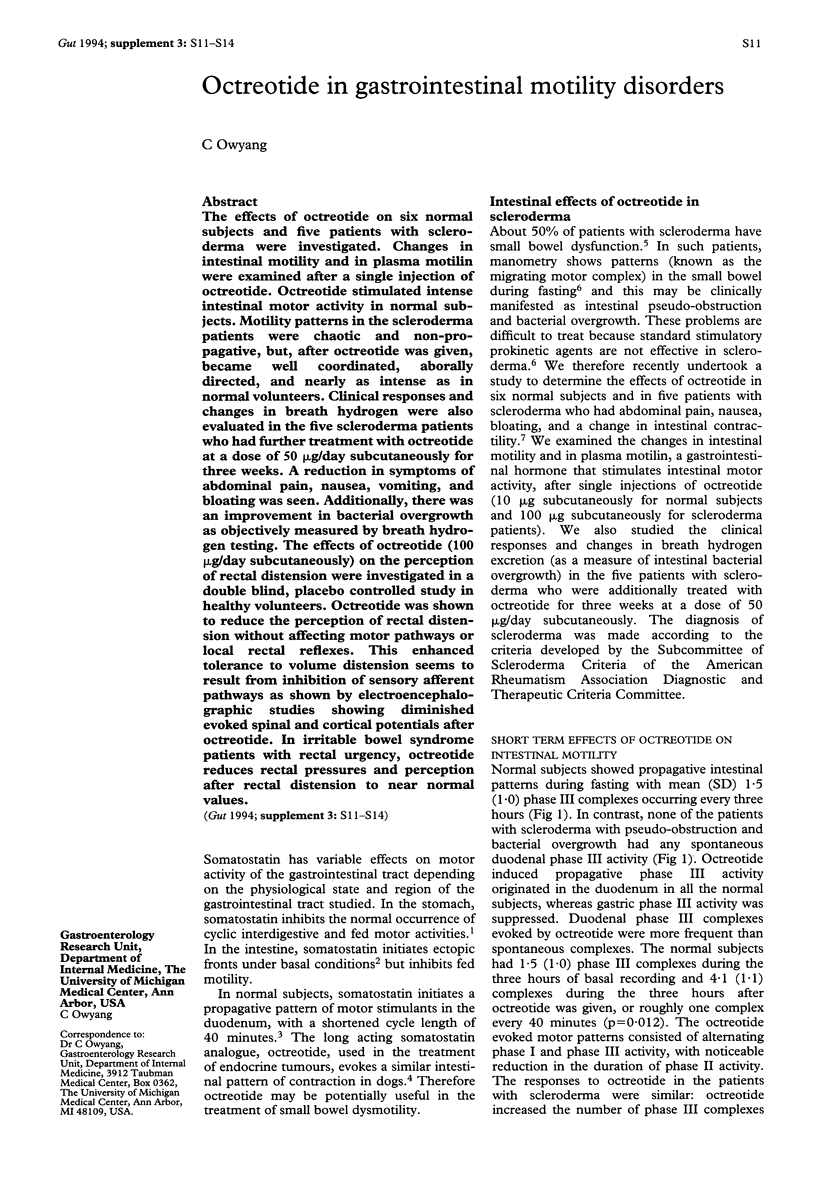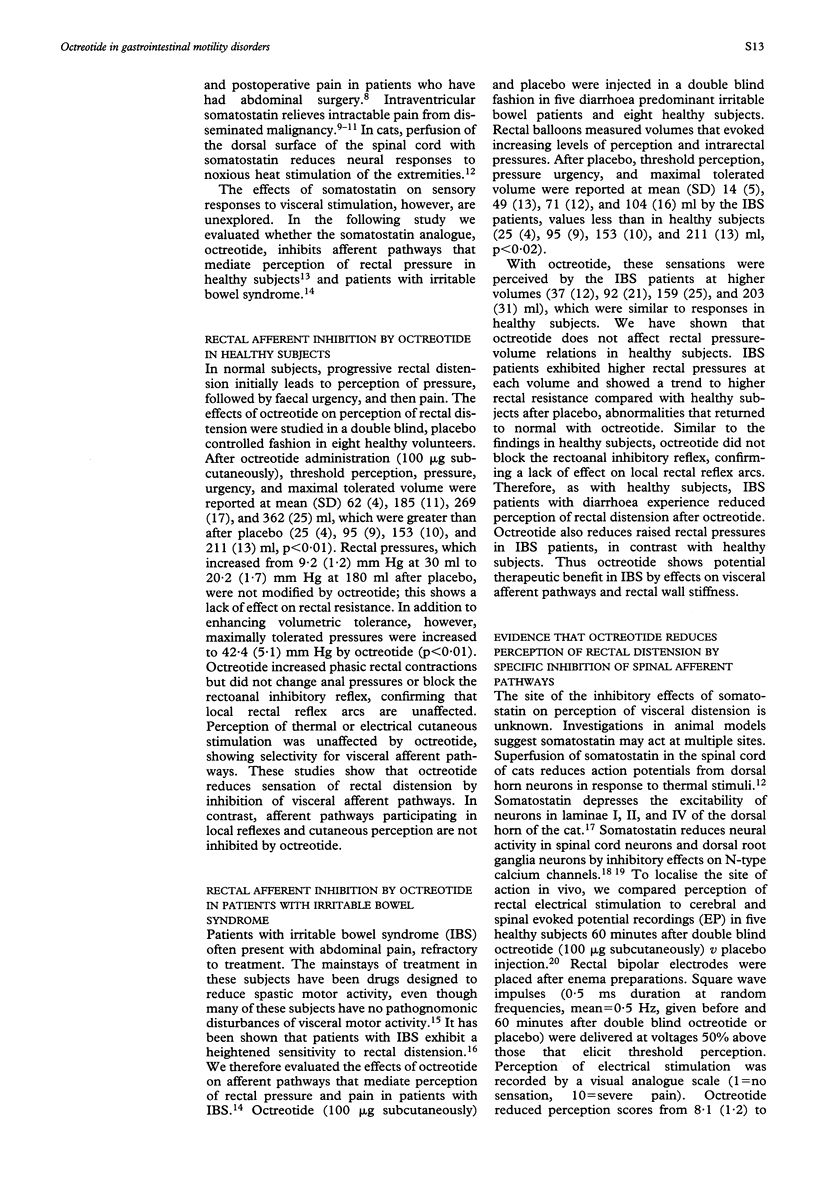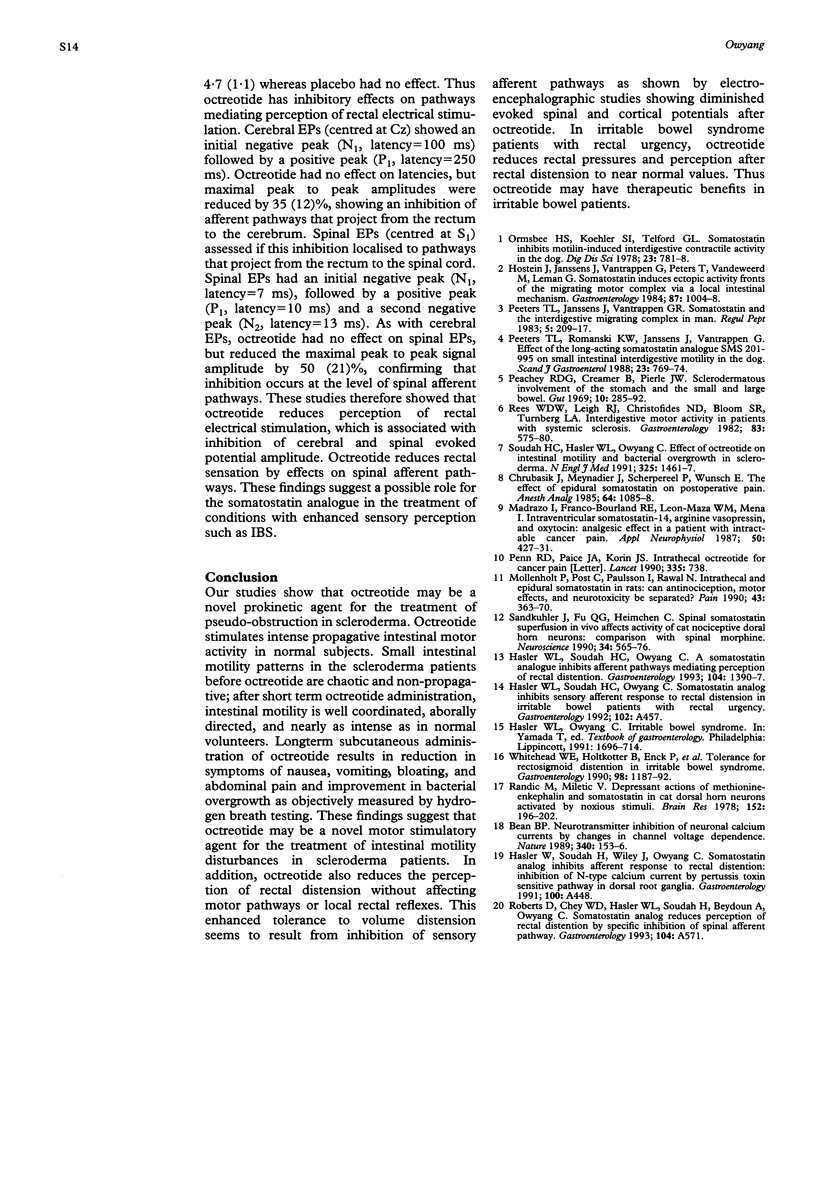Abstract
The effects of octreotide on six normal subjects and five patients with scleroderma were investigated. Changes in intestinal motility and in plasma motilin were examined after a single injection of octreotide. Octreotide stimulated intense intestinal motor activity in normal subjects. Motility patterns in the scleroderma patients were chaotic and non-propagative, but, after octreotide was given, became well coordinated, aborally directed, and nearly as intense as in normal volunteers. Clinical responses and changes in breath hydrogen were also evaluated in the five scleroderma patients who had further treatment with octreotide at a dose of 50 micrograms/day subcutaneously for three weeks. A reduction in symptoms of abdominal pain, nausea, vomiting, and bloating was seen. Additionally, there was an improvement in bacterial overgrowth as objectively measured by breath hydrogen testing. The effects of octreotide (100 micrograms/day subcutaneously) on the perception of rectal distension were investigated in a double blind, placebo controlled study in healthy volunteers. Octreotide was shown to reduce the perception of rectal distension without affecting motor pathways or local rectal reflexes. This enhanced tolerance to volume distension seems to result from inhibition of sensory afferent pathways as shown by electroencephalographic studies showing diminished evoked spinal and cortical potentials after octreotide. In irritable bowel syndrome patients with rectal urgency, octreotide reduces rectal pressures and perception after rectal distension to near normal values.
Full text
PDF



Selected References
These references are in PubMed. This may not be the complete list of references from this article.
- Bean B. P. Neurotransmitter inhibition of neuronal calcium currents by changes in channel voltage dependence. Nature. 1989 Jul 13;340(6229):153–156. doi: 10.1038/340153a0. [DOI] [PubMed] [Google Scholar]
- Chrubasik J., Meynadier J., Scherpereel P., Wünsch E. The effect of epidural somatostatin on postoperative pain. Anesth Analg. 1985 Nov;64(11):1085–1088. [PubMed] [Google Scholar]
- Hasler W. L., Soudah H. C., Owyang C. A somatostatin analogue inhibits afferent pathways mediating perception of rectal distention. Gastroenterology. 1993 May;104(5):1390–1397. doi: 10.1016/0016-5085(93)90347-f. [DOI] [PubMed] [Google Scholar]
- Hostein J., Janssens J., Vantrappen G., Peeters T. L., Vandeweerd M., Leman G. Somatostatin induces ectopic activity fronts of the migrating motor complex via a local intestinal mechanism. Gastroenterology. 1984 Nov;87(5):1004–1008. [PubMed] [Google Scholar]
- Madrazo I., Franco-Bourland R. E., León-Meza V. M., Mena I. Intraventricular somatostatin-14, arginine vasopressin, and oxytocin: analgesic effect in a patient with intractable cancer pain. Appl Neurophysiol. 1987;50(1-6):427–431. doi: 10.1159/000100753. [DOI] [PubMed] [Google Scholar]
- Mollenholt P., Post C., Paulsson I., Rawal N. Intrathecal and epidural somatostatin in rats: can antinociception, motor effects and neurotoxicity be separated? Pain. 1990 Dec;43(3):363–370. doi: 10.1016/0304-3959(90)90033-A. [DOI] [PubMed] [Google Scholar]
- Ormsbee H. S., 3rd, Koehler S. L., Jr, Telford G. L. Somatostatin inhibits motilin-induced interdigestive contractile activity in the dog. Am J Dig Dis. 1978 Sep;23(9):781–788. doi: 10.1007/BF01079786. [DOI] [PubMed] [Google Scholar]
- Peachey R. D., Creamer B., Pierce J. W. Sclerodermatous involvement of the stomach and the small and large bowel. Gut. 1969 Apr;10(4):285–292. doi: 10.1136/gut.10.4.285. [DOI] [PMC free article] [PubMed] [Google Scholar]
- Peeters T. L., Janssens J., Vantrappen G. R. Somatostatin and the interdigestive migrating motor complex in man. Regul Pept. 1983 Feb;5(3):209–217. doi: 10.1016/0167-0115(83)90252-5. [DOI] [PubMed] [Google Scholar]
- Peeters T. L., Romanski K. W., Janssens J., Vantrappen G. Effect of the long-acting somatostatin analogue SMS 201-995 on small-intestinal interdigestive motility in the dog. Scand J Gastroenterol. 1988 Sep;23(7):769–774. doi: 10.3109/00365528809090758. [DOI] [PubMed] [Google Scholar]
- Penn R. D., Paice J. A., Kroin J. S. Intrathecal octreotide for cancer pain. Lancet. 1990 Mar 24;335(8691):738–738. doi: 10.1016/0140-6736(90)90861-x. [DOI] [PubMed] [Google Scholar]
- Randić M., Miletić V. Depressant actions of methionine-enkephalin and somatostatin in cat dorsal horn neurones activated by noxious stimuli. Brain Res. 1978 Aug 18;152(1):196–202. doi: 10.1016/0006-8993(78)90148-8. [DOI] [PubMed] [Google Scholar]
- Rees W. D., Leigh R. J., Christofides N. D., Bloom S. R., Turnberg L. A. Interdigestive motor activity in patients with systemic sclerosis. Gastroenterology. 1982 Sep;83(3):575–580. [PubMed] [Google Scholar]
- Sandkühler J., Fu Q. G., Helmchen C. Spinal somatostatin superfusion in vivo affects activity of cat nociceptive dorsal horn neurons: comparison with spinal morphine. Neuroscience. 1990;34(3):565–576. doi: 10.1016/0306-4522(90)90165-z. [DOI] [PubMed] [Google Scholar]
- Soudah H. C., Hasler W. L., Owyang C. Effect of octreotide on intestinal motility and bacterial overgrowth in scleroderma. N Engl J Med. 1991 Nov 21;325(21):1461–1467. doi: 10.1056/NEJM199111213252102. [DOI] [PubMed] [Google Scholar]
- Whitehead W. E., Holtkotter B., Enck P., Hoelzl R., Holmes K. D., Anthony J., Shabsin H. S., Schuster M. M. Tolerance for rectosigmoid distention in irritable bowel syndrome. Gastroenterology. 1990 May;98(5 Pt 1):1187–1192. doi: 10.1016/0016-5085(90)90332-u. [DOI] [PubMed] [Google Scholar]


